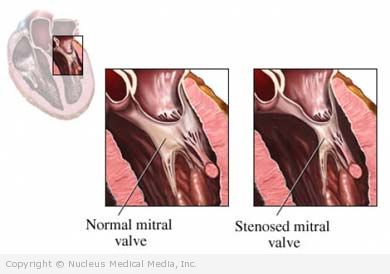Mitral stenosis in adult
(Mitral Valve Stenosis — Adult)
Mitral stenosis in adult – Definition
Mitral stenosis is a narrowing of the mitral valve in the heart. This valve is located between the atrium (upper chamber) and the ventricle (lower pumping chamber) of the left side of the heart. Blood must flow from the atrium, through the mitral valve, and into the ventricle before being pumped out into the rest of the body. Mitral stenosis results in inadequate blood flow between the two left chambers, and therefore too little blood and oxygen being pumped throughout the body.
Mitral stenosis in adult – Causes
The most common cause of mitral stenosis is rheumatic fever, which scars the mitral valve. A less common cause is a congenital defect, usually part of a complex of multiple heart defects present at birth. Very rare causes include blood clots, tumors, or other growths that block blood flow through the mitral valve.
Mitral stenosis in adult – Risk Factors
A risk factor is something that increases your chance of getting a disease or condition. The main risk factor for mitral stenosis is rheumatic fever. Other risk factors include:
- Sex: female
- Age: 30-50
Mitral stenosis in adult – Symptoms
Symptoms may include:
- Difficulty breathing, especially during exercise and when lying flat
- Awakening short of breath in the middle of the night
- Fatigue
- Chest pain, such as squeezing, pressure, or tightness (rare)
- Sensation of rapid or irregular heartbeat (palpitations)
- Cough with exertion
- Coughing up blood
- Swelling of the legs or feet
- Frequent respiratory infections
- Dizziness, fainting
Mitral stenosis in adult – Diagnosis
The doctor will ask about your symptoms and medical history, and perform a physical exam. The doctor may be alerted to mitral stenosis by the following:
- Abnormal chest sounds, such as a heart murmur or snap
- Stretching of a vein in the neck
- Signs of fluid in the lungs
Tests may include:
- Chest x-ray — a test that uses radiation to take pictures of structures inside the chest
- Electrocardiogram (ECG, EKG) — a test that records the heart’s activity by measuring electrical currents through the heart muscle
- Echocardiogram — a test that uses high-frequency sound waves (ultrasound) to examine the size, shape, and motion of the heart; in this test, the sound waves are passed through a transducer that is placed onto your chest.
- Transesophageal echocardiogram — uses the same ultrasound techniques to create an image of your heart, but gives a more detailed image. In this test, the transducer is passed down your esophagus (the tube in your throat that runs from your mouth into your stomach), to allow a better examination of the mitral valve.
- Cardiac catheterization — an x-ray of the heart’s circulation that is done after injection of a contrast dye
- Holter monitor — a portable EKG device that you wear for 24 or more hours, to detect heart rhythm abnormalities that often accompany mitral stenosis
Mitral stenosis in adult – Treatment
If you have mild mitral stenosis, your condition will need to be monitored, but may not need immediate treatment for symptoms associated with mitral stenosis. When symptoms become more severe, you may need to limit exertion and avoid high-salt foods. In addition, treatments may include:
Medications
Drugs may be prescribed to treat specific symptoms associated with mitral stenosis. These medications include:
- Drugs that lower the heart rate and improve the heart’s function (beta-blockers and calcium channel blockers)
- Water pills (diuretics)
- Blood-thinning drugs — Mitral stenosis can lead to blood clots that can go to the brain, causing strokes, or to the limbs, causing severe problems.
- Drugs to control heart arrhythmias
You may also need to take antibiotics when you have certain infections (eg, group B streptococcal disease, usually of the throat). This will help prevent further damage to your heart.
Surgery
Common types of heart valve surgery include:
- Mitral valvulotomy — A surgical cut or enlargement is made in the stenotic mitral valve to relieve the obstruction.
- Balloon valvuloplasty — A balloon device is inserted into the blocked mitral valve to open or enlarge the valve. This may provide temporary relief of symptoms. However, the valve may become blocked again.
- Mitral valve replacement — This is the surgical replacement of a defective heart valve. This surgery is usually delayed until symptoms are severe or the patient can no longer be helped by other procedures.
If you are diagnosed with mitral stenosis, follow your doctor’s instructions.
Mitral stenosis in adult – Prevention
Most cases of mitral stenosis can be prevented by preventing rheumatic fever:
- Treat strep throat infections promptly to avoid rheumatic fever, which can cause scarring of the heart valve; always finish all of the antibiotics prescribed, even if you feel better before taking all of the doses.
In addition, there are several things you can do to try to avoid some of the complications of mitral stenosis:
- Get regular medical care, including checkups and periodic electrocardiograms.
- Talk to your dentist and doctor about your condition before any medical or dental procedures. It is not routinely recommended anymore to take antibiotics to prevent infections before procedures, but it may be necessary in some cases.
- If your valve problem was caused by rheumatic fever, talk to your doctor about antibiotic treatment to prevent future episodes of rheumatic fever.
- Avoid caffeine, alcohol, and drugs (like decongestants) that speed up your heart rate; these will only worsen your symptoms.
- Maintain a healthy weight.
- Follow your doctor’s recommendations for exercise.
- Ask your doctor about cutting back on salt; this may help decrease the pressure in your heart and improve your symptoms.
- Monitor your blood pressure, and inform your healthcare provider if you seem to be developing high blood pressure, which can worsen your symptoms.

